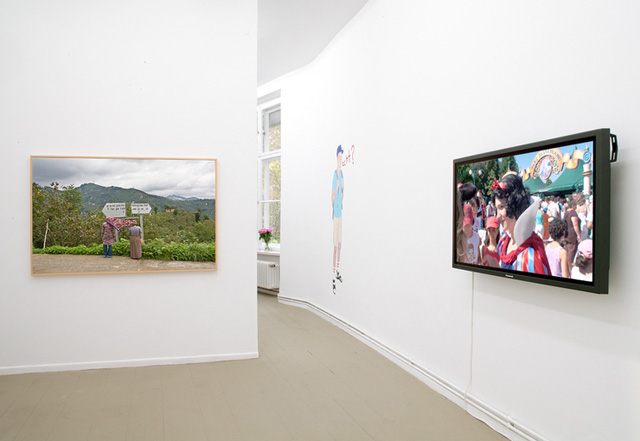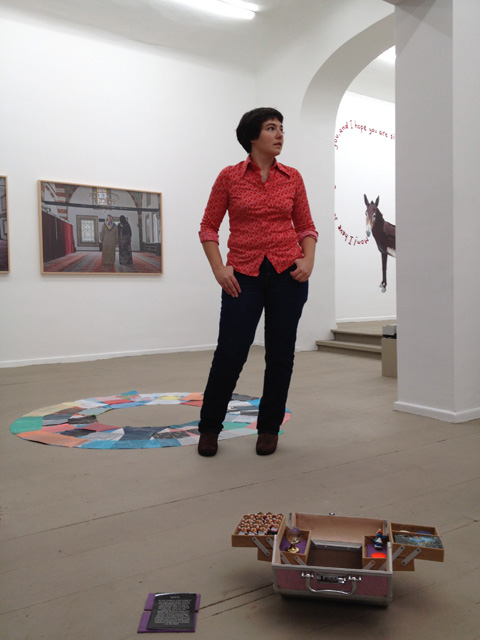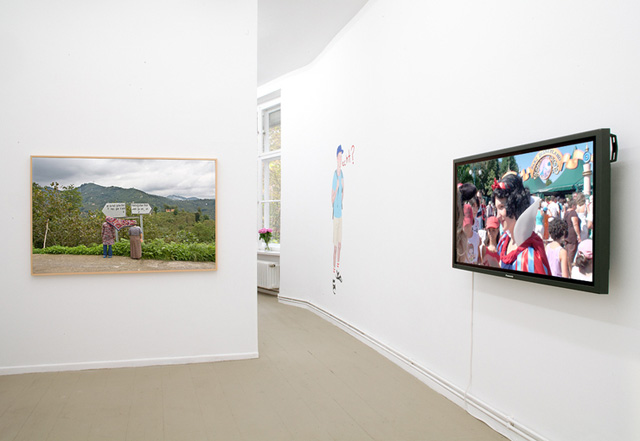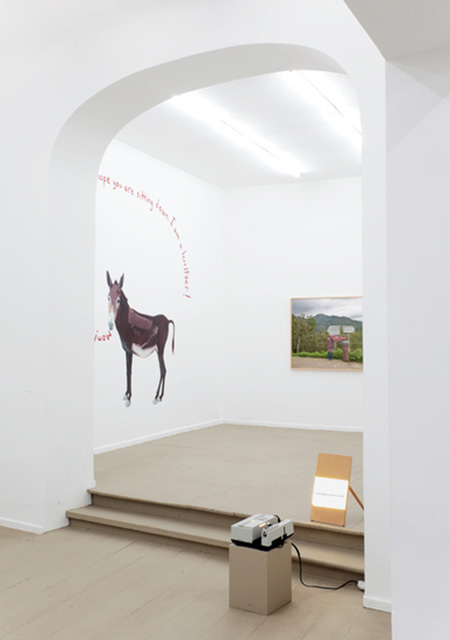Yeni Aya Cevaben / Responding to the New Moon / Antworten auf den Neumond: Prologue
11 November 2011–7 January 2012
Galerie Tanja Wagner is hosting the exhibition titled Yeni Aya Cevaben/ Responding to the New Moon/ Antworten auf den Neumonds: Prologue curated by Övül Durmuşoğlu.
Övül has recently moved to Berlin after having lived in Malmö, Vienna, New York and Stuttgart for her educational and project commitments. The reason for her coming to Berlin was initially to organize and install the Berlin step of Another Country- Eine andere Welt in ifa Berlin, a collaborative project of the Institute for Foreign Cultural Relations (ifa), Stuttgart and the Akademie Schloss Solitude, Stuttgart which she produced with a Rave Scholarship..
The exhibition Yeni Aya Cevaben/Responding to the New Moon/ Antworten auf den Neumonds: Prologue includes works by Hasan Aksaygın, Natalie Czech (in coll.with Ashkan Sepahvand and Mara Genschel), Nilbar Güreş, Runo Lagomarsino, Johannes Paul Raether, Anca Munteanu Rimnic and Pilvi Takala. During a short visit to the exhibition, performance, collaborative acts and a certain unlocking humor seemed to be some of the common threads running through the works. In order to help me relate to the curatorial framework and motivations, Övül has kindly sent her replies to a number of comments and questions.—Aslı Çetinkaya
Photo courtesy of Ahmet Öğüt
A.Ç.: English and Turkish titles both made me think of two works of literature which are also adapted for cinema: ‘New Moon (Twilight Saga)’ and ‘Ay Büyürken Uyuyamam/ I cannot Sleep while the Moon is Waxing’. The former is a well-known teenage drama of vampires and werewolves, while the latter is a collection of short stories by a Turkish writer, Necati Cumalı, which deal with sexual fantasies and deviations of rural people in Anatolia. Both works have elements of tension and apprehension linked to some lunar state.
Ö.D.: I’m glad you mentioned these references from contemporary culture. I consider Cumalı’s work also as a contemporary filmic reference like New Moon Twilight Saga in this sense because the tale Ay Buyurken Uyumam is recently scripted for a new melodrama directed by one of the veteran directors of Turkish cinema, Şerif Gören with well-known young actors and actresses public is familiar with because of their leading roles in Turkish soap operas. It is the story of a societal crisis triggered by partriarchal mechanisms of desire and control, a situation where the taken for granted patterns of collective consciousness do not work any more. I feel the moon reference touches the paganistic times of the land in this context. Both narratives are shaped by a certain touch of the folkloric. With regards to the New Moon saga, it is more a mutated format of the Gothic storytelling tradition where something spiritual always lurks behind and which represents a new generation’s sense of visual and conceptual imagination about another world.
A.Ç.: You draw a parallel between one particular phase of the moon and the uprisings, protests, collapses, which are challenging orders, institutions and investments all over the world. What does a new moon stand for or how is it interpreted? What effects are to be expected on people’s lives? Could you talk about the analogy you draw here?
Ö.D.: New moon is a phase of darkness, it stands for the new beginnings, challenging past formulations and questions in response to the new situations arising. Following the news, I myself am tired of the authorities insisting on forecasts for our moment through what they knew or experienced to retain their integrity. The collapses arriving in a domino effect show that we need to get rid of old formulations and develop new methods of survival and flexibility. Thus was the departure for my analogy. A time cycle closing with a demand for getting rid of rigid mental loops. That is also what Hannah Arendt suggests when she coins the phrase “the creativity of the unexpected,” she wants to draw our attention to the performative nature of the event. The works I brought together in the exhibition refer to that ‘dark side of the moon’ in their playful way.
Photo courtesy of Galerie Tanja Wagner
A.Ç.: As far as I know you are interested in teachings, methodologies or beliefs, which are often disregarded by scientific reasoning. Such as astrology or alternative healing or energy therapies like reiki. When I read the title of your show, somehow, I thought that it is befitting of your interest or trust of the power of the unexplainable? How do you think it relates to art and artistic production?
Ö.D.: Not only these “alternative” thinking models are mostly disregarded by serious enlightened reasoning, but also they have been turned into the cheesy tools of effectiveness to survive in the capitalist system. I’m very much aware of these complications when I use the phenomenon of the new moon. And I’m also interested in the fact that these models demand of us to re-think our physical limits, our bodies, our materiality and to re-shape it according to our own personal agenda in life. This is a strong proposal on how to re-connect with the world. On the other hand, it is a re-produced desire to expand in the wireless spaces of communication and interaction over the screens that fill our lives. The dream of limitlessness may be closest to this climax in that sense. What I’m interested in are the sensations and sensibilities in this environment of constant translations rather than a trust in the unexplainable. Indeed there is no more mystery in the workings of the art market. Yet I am curious of the variety of the artistic strategies responding to the situations in such an environment.
A.Ç.: You note that artists in the show ‘suggest or realize performative methodologies of material and process’. Could you speak about a couple of works and artists from this perspective?
Ö.D.: Responding to the New Moon’s perspective came from an inner demand to talk about the artists that I’m in constant dialogue with such as Nilbar Güreş, Dineo Bopape and Emre Hüner and with the artists I met in Berlin such as Anca Munteanu Rimnic, Natalie Czech and Nadira Husain in a different and personalized way. In the exhibition, the decision to show more than one work from an artist was a very conscious one to be able to create a different conversational ground on performance, material and process not only between the works but also between the works of the artist as well.
Photo courtesy of Galerie Tanja Wagner
That’s why in this Prologue, for example Nilbar Güreş has a strong presence with her diptych Worship/Women’s Only (2010), Junction (2010) and the recent video Wolf and Lamb (2011). Nilbar’s work is about a constant conceptual interaction among her chosen materials, gestures and histories. If we focus on the way she works with the textile material, for example, it is clear that her fascination with the textile appears in a different form each time in the objects, drawing collages, photographs and videos. Texture, colour and narrative are interwoven in a performative way through her surreal scenarios de-territorializing the taken-for-granted-gender constructions. The textile material plays a major conceptual role in the collage Self Defloration (2006), in Worship/Women’s Only (2010) and Junction (2010) the textile embodies the playful gesture, almost a field of communication between two women. While Wolf and Lamb (2011) enchants us with its choice of colours and a repeating sound loop of boo’s and mee’s, a careful observer may realize a textile surface appearing as a cover of a secret lump or body in the scene that should remain hidden. Every detail in her settings perform a major role in the narrative construction of her scenarios
Another standpoint in the exhibition comes from Berlin based Natalie Czech. Natalie has developed a curiously poetic and engaging way for dealing with the complex relation between text and image. Her series Hidden Poems shows photographs whose material basis consists of magazines, newspapers, or illustrated books. She traces her favourites from twentieth century poems in the existing text material such as e.e. Cummings, Vladimir Khlebnikov, Robert Lax and Jack Kerouac. She further complicates her appropriation method by commissioning different writers to create texts inspired by certain poems and asking them to hide the poem inside the text they write in a particular visual format. For ‘Responding to the New Moon’ she produced a new piece in that line. She asked two writers Mara Genschell and Ashkan Sepahvand to write texts inspired by 1916 dated famous Apollinaire poem ‘Il Pleut’, the poem was hidden in the texts in its original visual format. We vinyled both texts on the large beautiful windows of the gallery. Our intention was to create a narrative experience for the audience when they are already looking at the exhibition from outside. “The exhibition feels different outside and inside,” a colleague and friend said, so I can say it is really working in this rainy season of Berlin. Inside the exhibition, she greets us with a hidden poem by Khlebnikov on a found magazine page with a full moon picture saying ‘It’s not the same old moon”. Purely coincidental, the work was already there when I invited her for the exhibition.
A.Ç.: You refer to “new materiality” in the exhibition text. How do you define and relate to the term?
Ö.D.: New materiality is first of all an open-ended, provocative conceptual question addressing current artistic approaches. It aims to test whether it is possible for artistic practices to create their own vocabulary in experience. The question is very much related with the tension I have been mentioning above. There is the limitless desire of immaterial expansion over communication and interaction but there are also the limits for the horizontal organization around facebook, twitter and blogger. It is almost becoming a brand now; however the urge to get together, live and share a public space for voicing out what we don’t like ‘the occupation’ shows if there is a change that may happen, it comes from a material presence in a physical here and now. Artists respond to this tension of translation I try to exemplify here with their performance, process, material based approaches. Following the Groysian reading of the equality and multiplicity of the material, we may easily suggest that our perception of the artistic material and process has transformed accordingly. Not to forget how clearly he states that how everyone is involved in performance today in the obligation of a self design.
Photo courtesy of Galerie Tanja Wagner
A.Ç.: How did you happen to work with Galerie Tanja Wagner? Are there any other projects you started to work on or plan to do so?
Ö.D.: The exhibition has been the natural outcome of an ongoing conversation between Tanja Wagner and me. In Berlin, since there is not a kunsthalle structure where you can approach to develop new projects, the galleries are filling up an important space of exhibition and discussion for the scene. It is also a first time for me collaborating with a gallery. I have been working on the conception of ‘the new materiality’ so Yeni Aya Cevaben/ Responding to the New Moon/ Antworten auf den Neumond: Prologue developed easily into a starter exhibition. The project will follow in volumes, using not only exhibitions but also other formats for transforming itself. Another important thing is that with this project I want to create space to continue fruitful conversations with the artists involved. There are a few next steps coming soon, I prefer to disclose when they are fully ready.
Aslı Çetinkaya worked at Sabancı University Kasa Galeri as the gallery director from October 2004 to November 2010. Organized the selections and participation from Turkey at the Biennial of Young Artists from Europe and Mediterranean (BJCEM). Edited and coordinated the publication of ’10 years at Kasa’ for the10th anniversary of the gallery. Several articles, interviews and translations are published. Member of AICA Turkey since 2008. Currently works on a project within Tandem: Cultural Managers Exchange Program.
Övül Durmuşoğlu (born 1978) is a curator and writer who participated in the Critical Studies post graduate program at Malmö Art Academy, Malmö (2005–2006). In 2007 Durmuşoğlu was awarded the Premio Lorenzo Bonaldi Young Curators Award for her Data Recovery project GAMeC, Bergamo, and in 2010 she received a Rave Scholarship to work on a collaborative project of the Institute for Foreign Cultural Relations (ifa), Stuttgart and the Akademie Schloss Solitude, Stuttgart. Recent curatorial projects include: The New Horizon, STROOM, The Hague, 2010; My Voice My Weapon of Choice, Kasa Galeri, Istanbul, 2010; Sweet Anticipation, Salzburger Kunstverein, Salzburg, 2010-11; Yeni Aya Cevaben/ Responding to the New Moon/ Antworten auf den Neumond: Prologue, Galerie Tanja Wagner Berlin, 2011-12. Her projects in the public space of Istanbul include: Radikal Art: Face to Face, 2007 and EXOCITI, 2006. Durmuşoğlu lives and works in Berlin and Istanbul.




